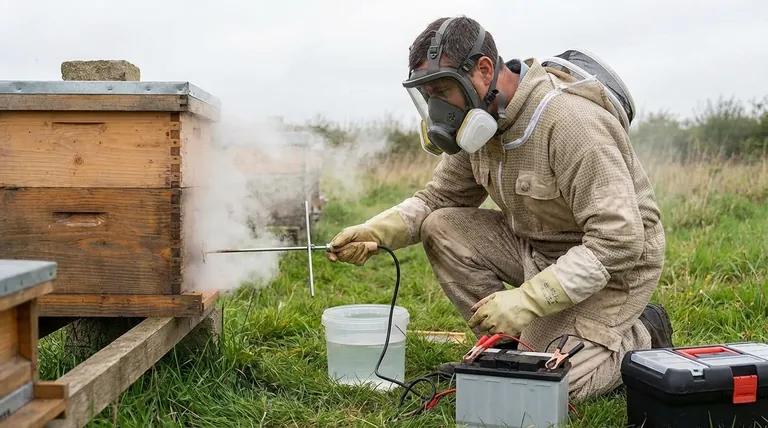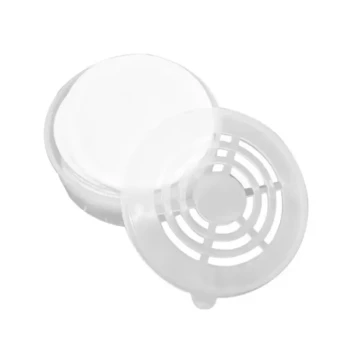When vaporizing oxalic acid, the most critical safety precautions are to wear a properly rated acid gas respirator, eye protection, and gloves, and to always position yourself upwind from the hive entrance. These measures are designed to prevent the corrosive acid vapor from contacting your lungs, eyes, or skin. You must follow the specific instructions on your EPA-approved oxalic acid label and the manufacturer's directions for your vaporizer.
The core principle of oxalic acid safety is straightforward: the vaporized acid is a severe respiratory irritant. All personal protective equipment and procedures are non-negotiable measures to prevent inhalation and direct contact.
The Core Risk: Why Vaporization Demands Respect
Understanding Oxalic Acid Vapor
Oxalic acid is an organic compound that is safe for bees at the correct dosage but is corrosive to human tissue, particularly the sensitive lining of the respiratory tract. When heated, the crystals turn into a fine vapor that, if inhaled, can cause significant and immediate damage to your lungs.
The Importance of Wind Direction
A simple gust of wind can blow the acid vapor directly into your face. Always check the wind direction before you begin and ensure you are standing upwind of the hive. This allows any vapor that escapes the hive entrance to be carried safely away from you.
Essential Protective Equipment
The Respirator: Your Most Critical Tool
This is not optional. You must use a properly rated acid gas respirator. The label on your oxalic acid product will specify the required rating. A simple dust mask or an N95 particulate mask is insufficient and will not protect you from the acid vapor. Ensure your respirator fits correctly and forms a tight seal around your face.
Eye and Skin Protection
Chemical-resistant gloves and safety glasses or goggles are also mandatory. Oxalic acid can cause burns on contact with skin and severe damage to your eyes. Having a supply of fresh water nearby is a wise precaution to quickly dilute any accidental spills on your gear or skin.
Executing the Treatment Safely
Preparing the Hive
Before treatment, seal any large cracks or openings in the hive to contain the vapor. Inserting an IPM grid board or ensuring a solid bottom board is in place can help reduce drafts and prevent vapor from escaping from underneath the hive. This not only improves the treatment's effectiveness but also enhances your safety.
Handling the Vaporizer
Vaporizer wands get extremely hot. Handle them with care to avoid burns to yourself or damage to your equipment. After treating a hive, some wands can be cooled quickly by dipping the heated bowl into a bucket of water, which reduces the risk of accidental burns as you move between hives.
Respecting Temperature Minimums
For the treatment to be safe for the bees and effective, the outside temperature should be at least 37°F (3°C). Treating in colder weather can put undue stress on the colony.
Common Pitfalls to Avoid
Using Inadequate Respiratory Protection
The most common and dangerous mistake is using the wrong type of mask. Again, a simple dust or particulate mask offers zero protection against acid gases. You must use a respirator with the correct acid gas cartridges.
Ignoring Wind and Hive Leaks
Failing to stay upwind or to properly seal the hive are simple errors that dramatically increase your risk of exposure. Treat every application as if a leak will occur and position yourself accordingly.
Mishandling Hot Equipment
After the application is complete, the vaporizer wand remains dangerously hot. Placing it on flammable material like dry grass or carelessly leaving it where someone could touch it is a significant hazard. Have a designated, safe place to set the hot vaporizer down.
Making the Right Choice for Your Goal
To ensure a safe and effective treatment, approach the process with a clear plan.
- If your primary focus is personal safety: Your non-negotiable items are a properly fitted acid gas respirator and always staying upwind of the hive.
- If your primary focus is bee health and treatment efficacy: Seal all hive cracks and ensure the ambient temperature remains above 37°F for several hours post-treatment.
- If your primary focus is safe equipment handling: Choose a durable vaporizer you are comfortable with and always have a bucket of water for rapid cooling after use.
Ultimately, treating oxalic acid vaporization with methodical precision is the key to protecting both yourself and your bees.

Summary Table:
| Safety Precaution | Key Details | Why It's Critical |
|---|---|---|
| Respirator | Acid gas respirator (not a dust mask) | Prevents severe lung damage from corrosive vapor |
| Eye & Skin Protection | Safety goggles and chemical-resistant gloves | Protects from burns and eye damage |
| Wind Direction | Always position yourself upwind of the hive entrance | Blows any escaped vapor away from you |
| Hive Preparation | Seal cracks and ensure a solid bottom board | Contains vapor, improving safety and efficacy |
| Temperature | Minimum 37°F (3°C) ambient temperature | Ensures treatment is safe for the bee colony |
Protect Your Apiary with Professional-Grade Equipment
Safely managing your hives requires reliable, high-quality gear. At HONESTBEE, we supply commercial apiaries and beekeeping equipment distributors with the durable, wholesale-focused supplies needed for effective and safe operations—from protective equipment to vaporizers.
Contact our team today to discuss your wholesale needs and ensure your beekeeping practices are both safe and successful.
Visual Guide

Related Products
- Oxalic Acid Vaporizer 12V for Bee Varroa Mite Treatment
- Heavy Duty 12V Oxalic Acid Evaporator Vaporizer for Bee Varroa Mite Treatment Beekeeping Fumigator Atomizer
- 12V Bee Mite Removal Evaporator Oxalic Acid Vaporizer for Bee Fumigation Treatment 180W Atomization
- Compact Circular Bee Mite Treatment Dispenser
- Semi Automatic Round Bottle Labeling Machine
People Also Ask
- What should be done after applying the vapor? A Step-by-Step Guide to Sealing Your Hive
- What are the methods for applying oxalic acid in beekeeping? Control Varroa Mites Effectively
- What should be inserted under the hive to reduce drafts during oxalic acid vaporization? Ensure Effective Varroa Mite Control
- What are the registered application methods for oxalic acid in beekeeping? Choose the Right Varroa Mite Treatment
- How is the oxalic acid solution prepared for vaporization? No Solution Needed—Use Dry Crystals for Varroa Control



















